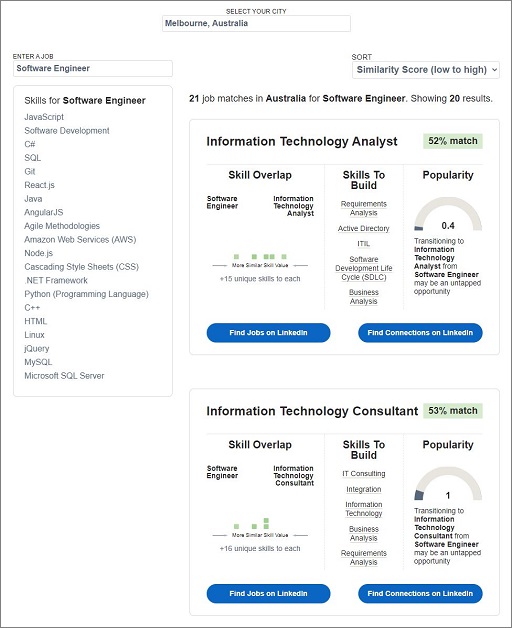Corporate social media platform LinkedIn is trying to help people find alternate avenues for their jobs with its newly launched Career Explorer tool.
Using data from over 700 million LinkedIn profiles, the company has tabulated sets of skills that are found in different jobs and pulled it into a simple tool.
“Through this interactive dashboard, job seekers will be able to explore potential next jobs that they can take, as well as the LinkedIn Learning courses or learning paths they can take to build the necessary skills,” LinkedIn said.
Like a kind of social media guidance counsellor, the idea is that you enter your current occupation and LinkedIn spits out some other jobs that you might already be nearly qualified for, based on the skills common to your existing role, but haven’t considered.
It then shows the skills you might need (those that are unique to the alternative career) and hyperlinks to find existing job ads and relevant people to ‘connect’ with out of the blue.
For LinkedIn’s default example ‘food server’ – a category with high levels of unemployment due to COVID-19 – the tool produces a variety of different careers outside hospitality in areas like marketing, administration, events, sales, and pharmacology.
But for IT professions the Career Explorer tool seems unlikely to produce results outside IT, often suggesting roles with little variation at all.
Suppose you’re a software engineer in Melbourne, for example. Of 21 potential career results, not a single one was outside IT and many are a variation on ‘consultant’, ‘engineer’, or ‘developer’.
On the positive side, if you are looking to pivot towards different areas such as consultancy, management, or an adjacent area, LinkedIn’s dashboard will help you identify some of the needed skills employers in those areas will look for.
LinkedIn's comparison tool keeps IT professionals within IT.
Professionals in the ‘software and IT services’ category are among the least likely to look for jobs outside their current industry, according to LinkedIn.
Unsurprisingly, people in ‘recreation and travel’ are most likely to look for work in different sectors, followed by ‘education’ and ‘real estate’.
With Australia’s COVID-19 curve well and truly flattened, the outlook has turned positive recently, according to LinkedIn’s APAC Director or Talent Solutions, Adam Gregory.
“We are seeing a growth in job postings in frontline sectors such as ‘transport and logistics’ and ‘health care’, whilst a decline in sectors such as ‘consumer goods’ and ‘hardware and networking’,” he said.
“Competition for jobs is also starting to ease. After nearly doubling in the middle of 2020, the applications per job is going back down to pre-COVID levels.”
Last month’s Australian Bureau of Statistics labour force data showed unemployment continued to trend upward, hitting 6.9 per cent with an underemployment rate of 11.4 per cent.
LinkedIn is positioning itself as a positive force for economic recovery.
Along with the Career Explorer tool, the Microsoft-owned social media platform this week announced a new ‘freemium’ job advertising feature designed to let small businesses place job ads on the site without having to fork out for a premium subscription.
It has also added the #Hiring feature which signals to site users when an organisation is on the hunt for new staff.











